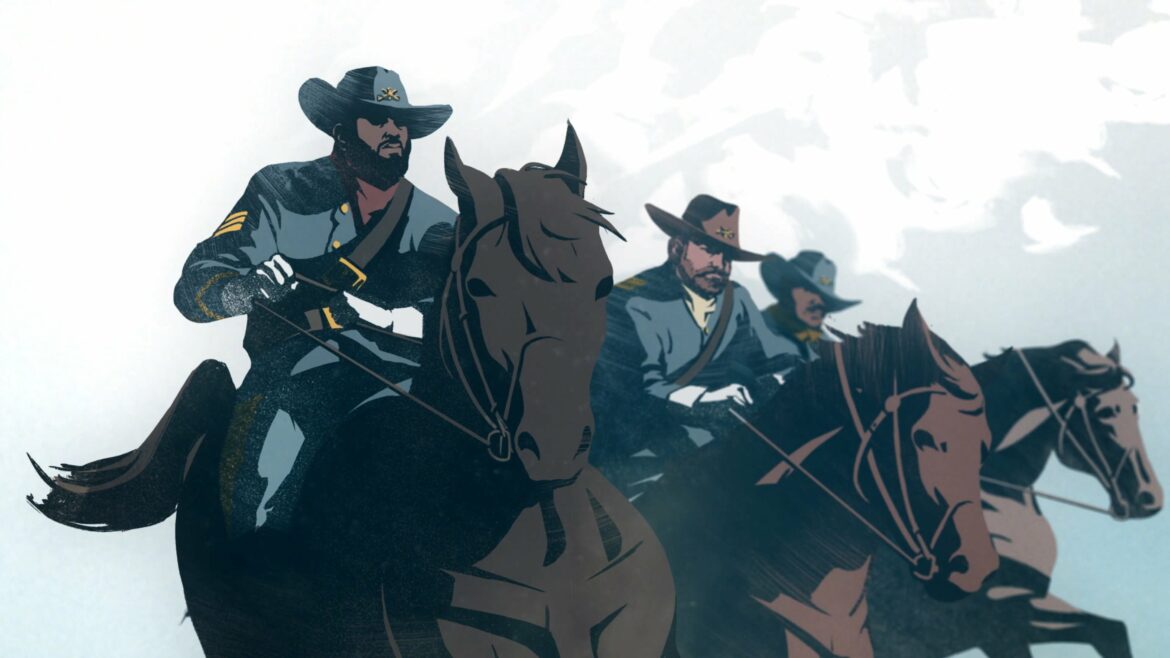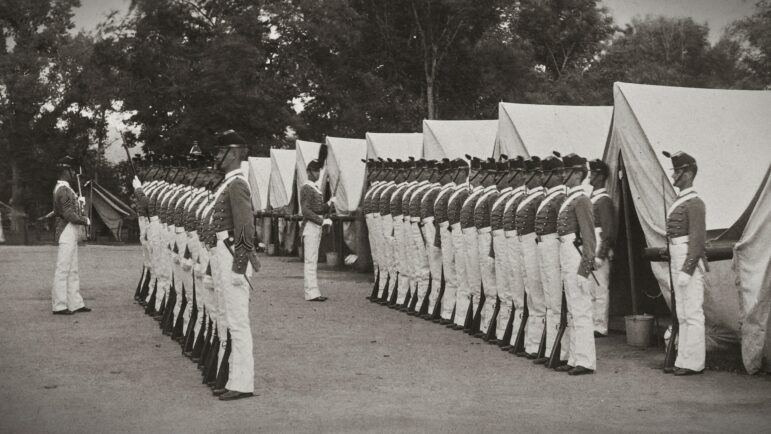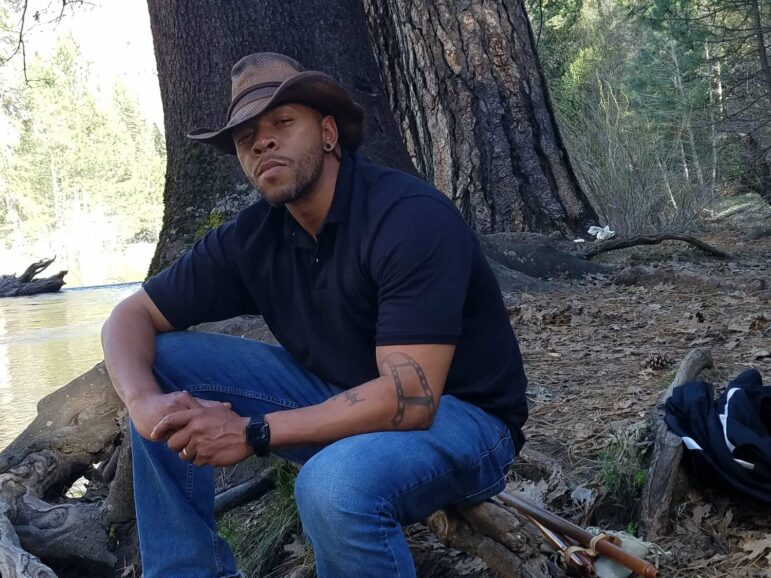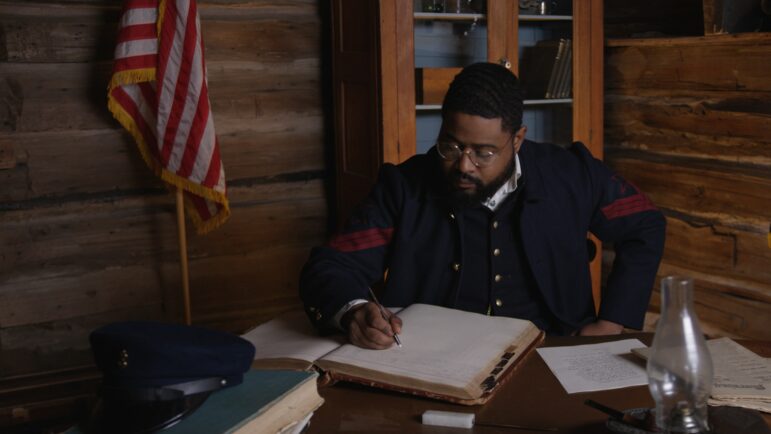Documentary on buffalo soldiers leads slate of PBS-backed projects by emerging filmmakers

Courtesy of Black Bald Films
"Buffalo Soldiers: Fighting on Two Fronts" uses some graphic novel-style animation to tell its story.
The idea for Dru Holley’s new public television documentary on the buffalo soldiers originated from a question posed by his daughter.
In 2018, Holley volunteered at a Juneteenth event in Seattle celebrating Langston Hughes and brought his then-six-year-old child with him. At one point, she saw a reenactment of a regiment of Black men riding horses and exclaimed “Oh, horsies!”
The men “looked like they came straight out of the 19th century … super authentic, galloping up the hill on horseback,” Holley recalls. Curious, the girl asked her father who the men were or what they were depicting.
The correct response was at the tip of Holley’s tongue — he knew he knew it, deep down — but the fact that he couldn’t identify the cavalry soldiers who the reenactors were depicting disappointed him.
Buffalo Soldiers: Fighting on Two Fronts, a documentary that Holley started to research as a way to answer his daughter’s question, premiered on PBS June 12 and on World, the multicast channel from GBH in Boston, on Juneteenth. It is by far the most challenging artistic project Holley has undertaken as a filmmaker. For five years, Holley has sought to tell the history of the buffalo soldiers, the popularized name for all-Black units of soldiers who served in the U.S. Army on the American frontier after the Civil War.
The documentary combines graphic novel-styled animation, actors reenacting key battles, archival photographs and commentary by historians. Holley focused the narrative on what it meant for Black soldiers to fight on behalf of a nation that largely continued to treat them with prejudice and disrespect. He also examined the buffalo soldiers’ missions attacking Native American and Indigenous peoples during America’s westward expansion.

Holley’s film came to public television through a diversity, equity and inclusion initiative created by PBS in 2021. Chief Programmer Sylvia Bugg set aside funds for an open call for proposals from diverse filmmakers. The effort was a response to filmmakers who challenged PBS to work with more filmmakers and came at a time when directors and producers were openly discussing how difficult it is to acquire funding to complete their public television documentaries.
This January, PBS announced the outcome of the open call. Filmmakers who proposed broadcast-length projects (30-, 60- or 90-minute programs), including Holley, received up to $50,000 in funding. Producers of short films (8- to 25-minutes) were eligible for up to $15,000.
Response to PBS open call
Adaora Udoji, PBS VP of programming and operations for general audience, said PBS invested roughly $600,000 in the eight projects that were selected. Films from more of these producers will premiere soon, she said, though specific dates haven’t been announced.
“There was no restriction on theme,” Udoji said, meaning that PBS didn’t limit the open call to projects on specific topics. “The idea literally was just to provide an opportunity for those creators that we may not have worked with before,” she said. “It literally was to open the door to say, ‘If you have something that makes sense for PBS, please participate in this.’”
They received “hundreds” of applicants, she said, and the pool was competitive. Holley’s documentary was one of the films that was furthest along by the time PBS connected with him.

“Dru did a phenomenal job,” Udoji said. “As an indie filmmaker, he understood that it’s a business.” Holley organized “dozens and dozens and dozens of screenings” and “really worked incredibly hard to get his project [in publications like] Ebony.”
“He was like a tornado of really pushing his film into the conversation,” Udoji said.
As hard as it is for independent filmmakers to build financial support and visibility for their projects, Holley “is textbook” for how to do that in the current environment, she said, “which is relentlessly pursuing funders, relentlessly pursuing marketing and publicity opportunities and relentlessly networking across the board. And it’s a wonderful film.”
One of Udoji’s favorite parts from Buffalo Soldiers: Fighting on Two Fronts is within the first five minutes. The segment examines the history behind a famous photograph of future President Thedore Roosevelt and the Rough Riders that was taken in Cuba after they’d charged San Juan Hill. Anthony L. Powell, a historian, author and museum curator who appears in the film, notes that Roosevelt made that charge after buffalo soldiers and a white regiment had breached the enemy’s defenses. The camera lens widens the view of the iconic photo, showing that Roosevelt and his Rough Riders were standing in the middle, with Black soldiers around them in the shot.
“That’s a metaphor for what happened on San Juan Hill,” said Quintard Taylor, a professor emeritus at the University of Washington, in a scene from the documentary. “It was a victory that belonged as much to buffalo soldiers.”
Expanding on his original idea
The film’s original title was Buffalo Soldiers of the Pacific Northwest and its scope was much narrower.
Holley initially planned to produce what he called a promotional film honoring Black patriots in history whose achievements hadn’t been recognized. A primary focus for that concept was Moses Williams, a Black man and Medal of Honor recipient who died in 1899. The buffalo soldier was buried at Vancouver Barracks Post Cemetery, which is near Holley’s home. The filmmaker drives by the grave site whenever he gets on or off the highway.

Over time, Holley learned more about the buffalo soldiers’ role in the Indian Wars that displaced Native people, and about important stories of Black men and women who served as buffalo soldiers. These discoveries convinced Holley that he needed to think beyond the Pacific Northwest if he wanted to tell a complete story, one that would be embraced by educators, parents of high-school students and the young and old alike.
“I was under the delusion that I was going to get it done in a year,” Holley said of the filmmaking process. “That delusion was good, because if I had known it would take years I might’ve said ‘Nah, I’m not doing that.’”
Holley’s final cut does include the story of Williams, who was one of the first Black men to attend West Point. He also documents the history of Cathay Williams, a woman who served as a buffalo soldier under the name William Cathay.
Holley is also proud of the musical direction for the film. It would’ve cost too much money to acquire rights to play snippets of Bob Marley’s song “Buffalo Soldier,” released in 1983. So the team found other songs that reference the Black soldiers, including a track from Quincy Jones. The film opens with an original composition by The Persuasions, an a cappella group, that gets into the story of how the name “buffalo soldier” may have been coined.
As for the film’s title referencing a fight on two fronts, Holley wanted the project to be guided by the fact that Black soldiers were fighting on behalf of America while also fighting Jim Crow laws and, later, organizing to secure civil rights.
“I want people to know what Black Amerians have contributed to this country since its beginning, since its first wars,” Holley said.
Network of support
While Buffalo Soldiers: Fighting on Two Fronts is Holley’s first official foray in public television, he has been building relationships with key programmers, creatives and funders for a couple of years. Among his contacts are Chris Hastings, EP and editorial manager for World at GBH. “Chris has been my guardian angel almost as I worked on this project,” Holley said. “He’s been patient with me.”
Holley was selected in 2020 for the Firelight Documentary Lab Fellowship, participated in the Black Public Media 360 Incubator and was selected for the 2022 Better Angels Levine fellowship, established in 2021 as a component of the Library of Congress Lavine/Ken Burns Prize for Film.
The learning curve for this big project meant that Holley had to improve his ability to fundraise, manage a team and handle deadlines. He also had to learn how to be told “no” repeatedly.
“That’s something you got to realize if you’re going to be a filmmaker: You will get told no every day,” Holley said. “You will get told a hundred ‘nos’ to one yes, so get in all your ‘nos’ first, because they’re coming.”
Holley expressed gratitude for the team that supported him, including producer Debra Simon, who was a production manager for the 2020 PBS four-part series Hacking Your Mind; Dan Evans, editor and story producer with credits for National Geographic, PBS and Oregon Public Broadcasting; and Iana Amauba, who oversaw motion graphics for Buffalo Soldiers. Holley credits her for keeping the project artistically consistent.
Holley also cited associate producer and researcher David-Paul B. Hedberg, who began working with him at the beginning of the project.
What’s next for Holley
On June 12, Buffalo Soldiers: Fighting on Two Fronts was released on World’s YouTube channel. It has garnered more than 275,000 views. One person who commented on the film noted that a well-researched documentary on the buffalo soldiers was “overdue.”
Holley probed the complex racial issues surrounding this history. The buffalo soldiers’ attacks on Native Americans, and the complicated relations between Blacks and Indigenous peoples, are continuous themes woven into the film. Holley set out to simultaneously honor the legacy of the buffalo soldiers while giving viewers the full scope of their role in Black history.
“We’re constantly told that our history is [only] slavery, Civil Rights, the ghetto and entertainment now,” he said. Without additional knowledge of Black people’s histories, the entire country misses out on important messages and lessons that can shape tomorrow, he said.

The experience of producing Buffalo Soldiers: Fighting on Two Fronts shaped Holley’s ideas for creating more historical documentaries. He’s considering a film project on the prison industrial complex. He also wants to work on a documentary about a group of Indigenous people who, after a Congressional authorization in 1866, served as scouts for the U.S. Army. He’s roughly calling it Native Scouts: Fighting on Two Fronts.
“I can’t tell that story as a director but I can definitely produce it,” Holley said. “I need a Native American director to help tell that story, because that’s just what’s right.”
What does Holley’s now 11-year-old daughter think of the buffalo soldiers, now that her father has produced and directed an hourlong response to her question? Well, she hasn’t seen the full-length film yet, though he plans to watch it with her when she’s older.
For the time being, he thinks she’ll be able to digest the content in another way.“We have some segments now that can go on TikTok that GBH and PBS made,” he said. “I think she’ll consume that much better.”





